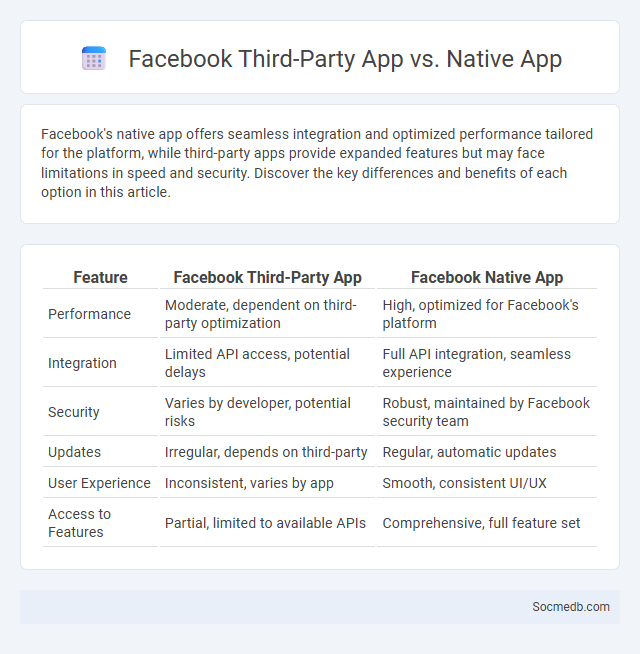
Photo illustration: Facebook Third-Party App vs Native App
Facebook's native app offers seamless integration and optimized performance tailored for the platform, while third-party apps provide expanded features but may face limitations in speed and security. Discover the key differences and benefits of each option in this article.
Table of Comparison
| Feature | Facebook Third-Party App | Facebook Native App |
|---|---|---|
| Performance | Moderate, dependent on third-party optimization | High, optimized for Facebook's platform |
| Integration | Limited API access, potential delays | Full API integration, seamless experience |
| Security | Varies by developer, potential risks | Robust, maintained by Facebook security team |
| Updates | Irregular, depends on third-party | Regular, automatic updates |
| User Experience | Inconsistent, varies by app | Smooth, consistent UI/UX |
| Access to Features | Partial, limited to available APIs | Comprehensive, full feature set |
Introduction to Facebook App Ecosystem
Facebook App Ecosystem encompasses a vast network of interconnected applications, tools, and services integrated within the Facebook platform, enabling seamless user interactions, content sharing, and third-party app development. Developers leverage Facebook's Graph API, SDKs, and social plugins to create engaging experiences that harness user data while adhering to privacy standards. This ecosystem supports a diverse range of apps, from gaming and entertainment to business and marketing solutions, driving user engagement and expanding the platform's social connectivity.
Defining Native vs Third-Party Facebook Apps
Native Facebook apps are built and maintained by Facebook, offering seamless integration and full access to platform features and data. Third-party Facebook apps are developed by external developers, often requiring user permissions to access certain data and functionalities via Facebook's API. Understanding these distinctions helps you make informed decisions about privacy, security, and the user experience when interacting with different Facebook applications.
Key Features of Facebook Native App
Facebook Native App provides seamless user experience with intuitive navigation and fast loading times. It supports real-time notifications, multimedia sharing, and integrated messaging through Messenger. Advanced privacy controls and customizable news feeds enhance user engagement and security on the platform.
Functionality Overview of Facebook Third-Party Apps
Facebook third-party apps enhance your social media experience by seamlessly integrating with the platform to offer additional functionalities such as games, event management, and personalized content sharing. These apps access your Facebook data through APIs, enabling features like login authentication, social graph insights, and customized notifications. Developers constantly optimize these tools to improve user engagement, streamline communication, and support various multimedia formats within the Facebook ecosystem.
Performance Comparison: Native vs Third-Party Apps
Native social media apps deliver superior performance due to direct access to device hardware and optimized code, resulting in faster load times and smoother interactions. Third-party apps often face limitations in speed and responsiveness because of API restrictions and additional development layers. User engagement and retention rates are typically higher on native platforms, underscoring their efficiency in delivering seamless social media experiences.
Security and Privacy Considerations
Protecting Your personal information on social media requires strong password management, two-factor authentication, and regular privacy setting reviews. Avoid sharing sensitive data such as location, financial details, or personal identification to minimize risks of identity theft and hacking. Staying vigilant against phishing scams and suspicious links ensures your online security remains intact.
User Experience Differences
Social media platforms vary significantly in user experience due to interface design, content algorithms, and interactive features. Facebook emphasizes community building with extensive group functions, while Instagram focuses on visual storytelling through images and short videos. Twitter prioritizes real-time updates and concise communication, encouraging rapid information exchange and trending topic engagement.
Integration and Compatibility Factors
Seamless integration of social media platforms with your existing marketing tools enhances campaign efficiency and data consolidation. Compatibility factors such as API availability, cross-platform functionality, and real-time analytics ensure smooth operations and optimized user engagement. Choosing platforms that align with your business software ecosystem maximizes ROI and simplifies content management workflows.
Pros and Cons of Each Facebook App Type
Facebook offers various app types including Pages, Groups, and Marketplace, each with unique advantages and disadvantages. Pages provide businesses and public figures a platform for brand promotion and customer engagement but may struggle with organic reach due to algorithm changes. Groups foster community interaction and targeted discussions, benefiting niche audiences, yet can become difficult to moderate and may limit exposure beyond members. Marketplace facilitates local buying and selling with ease, offering convenience and direct transactions, but risks issues with trust and fraud without robust verification systems.
Choosing the Right Facebook App for Your Needs
Selecting the right Facebook app depends on your specific needs, such as business management, content creation, or personal use. Facebook Business Suite offers comprehensive tools for managing pages, ads, and messages, ideal for marketers and small businesses. For casual users, the standard Facebook app provides a seamless experience for social networking, while Facebook Creator Studio supports content creators with post scheduling and analytics.
 socmedb.com
socmedb.com